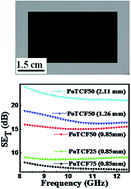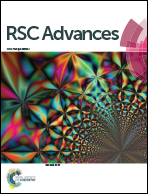Lightweight and solution processible thin sheets of poly(o-toluidine)-carbon fiber-novolac composite for EMI shielding†
Abstract
An attempt has been made to generate lightweight and processible thin sheets of poly (o-toluidine)-carbon fiber (PoTCF) composite for electromagnetic interference shielding. PoTCF composite synthesized by oxidative emulsion polymerization was physically blended with different weight ratios of novolac resin to prepare a new class of composite material, which was further processed to form thin sheets (thickness of ∼0.85 mm) by a compression moulding technique. In situ incorporation of carbon fiber into the polymer matrix leads to the formation of composites with improved mechanical, thermal, electrical and shielding properties, which were further optimized by varying the amount of novolac resin in the sheets. Structural and morphological studies were carried out by UV-vis, FTIR, XRD and SEM. PoTCF composite sheets with 50 wt% loading of novolac resin have flexural strength of 36.0 MPa and exhibit a shielding effectiveness of 24 dB in the X-band (8.2–12.4 GHz) at a critical thickness of ∼2.11 mm, which is more than the limit required for techno-commercial applications. Therefore, indigenously fabricated polymer-based sheets would be potentially useful for making durable enclosures for electronic equipment.


 Please wait while we load your content...
Please wait while we load your content...